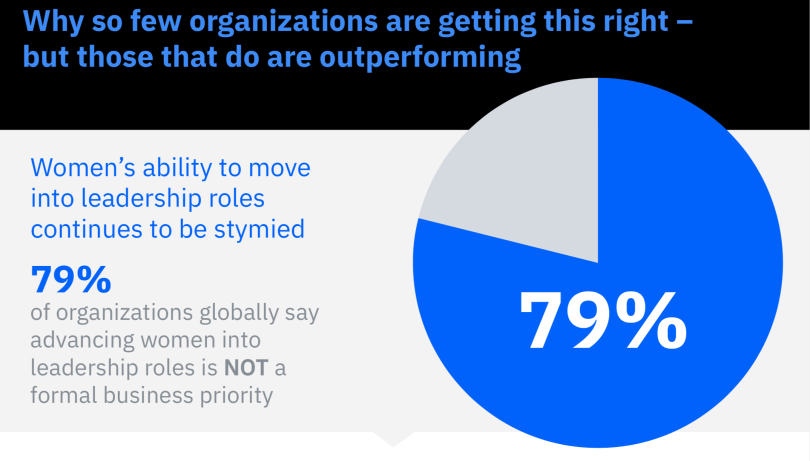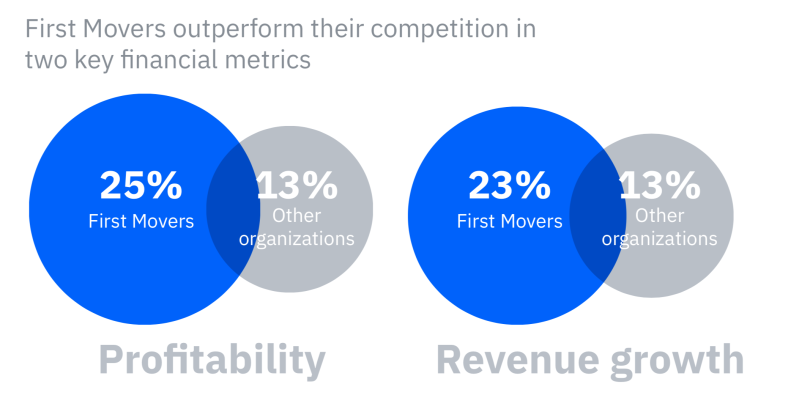Most tech companies will tell you they want to hire and promote more women, but how many make it a real priority?
In early 2019, IBM’s Institute for Business Value conducted a survey of 2,300 organizations worldwide and found that women hold just 18 percent of leadership roles in those companies. Seventy-nine percent of companies surveyed said that promoting women into leadership roles is not a formal business priority to them.
But the survey also found a small cohort of businesses that do prioritize advancing women’s careers. These companies, which IBM calls “First Movers,” report outperforming their competition in revenue growth, profitability and employee satisfaction. IBM analyzed those results and identified four key strategies that other organizations could follow to help close the gender gap and improve company culture.
IBM's Diversity Initiatives started early for the tech industry

The four key strategies that “First Movers” are using:
- They provide career development planning specific to women’s needs. IBM has career development programs focused on building relationships and influence to help women advance into leadership roles.
- They use the same metrics for men’s and women’s job performance evaluations and apply them equitably.
- They provide men and women with equal career opportunities.
- They work hard to create a culture that embraces women’s leadership styles. At First Mover companies, all executives regularly challenge gender-biased behaviors and language.
See how your employer brand is performing in AI tools like ChatGPT and Google.
Putting diversity strategies into action
At IBM, diversity initiatives long predate current conversations. IBM first launched its diversity and inclusion programs in the ‘90s, not only to help more women join the tech industry but to see them advance into leadership roles and enjoy longer, more successful careers.
Prioritizing diversity and inclusion at a large multinational corporation with thousands of employees has immense challenges, said Inhi Suh, general manager of IBM Watson Customer Engagement, based in IBM’s San Francisco office. But, she added, it’s an issue that major players like IBM have a responsibility to address.
“Large institutions and the companies they impact have a corporate responsibility to [participate] in how the next round of tech is built,” said Suh, who is also the co-chair of IBM’s Global Women Diversity Initiative.
After becoming an executive at a young age, Suh realized she had an opportunity to impact how the company approaches hiring and promoting diverse talent. “I became an executive at 29 years old and that afforded me a greater understanding of the responsibility, not only of being a woman in leadership, but also Asian and young,” she said.

Suh has now been a member of IBM’s women’s council for 10 years and she’s been co-chair since 2014. The council is comprised of 20 senior executives — women and men alike —who come from Latin America, Asia-Pacific, Europe and the U.S. They partner with IBM’s human resources department to improve results because, “[diversity] is not just an HR problem,” Suh said. “It’s as much about leadership and management.”
Today, the Global Women’s Diversity Initiative has three main objectives: to promote diversity and inclusion in the way they operate, to help accelerate the talent and the pipeline of talent, and to create a network where executives — irrespective of gender — really extend their ability to impact their teams, as well as who they interact with outside the office.
“[Diversity] is not just an HR problem. It’s as much about leadership and management.”
Some of the IBM programs designed specifically to assist women in career advancement include the “Building Relationships and Influencing” course for women who will soon enter executive roles, and the “Pathways to Technical Leadership” program, which helps the next generation of technical leaders identify career aspirations and provides learning opportunities. The program has increased the number of women, as well as minority men, in executive technical roles at the company.

As part of its larger D&I strategy, Suh said, IBM has several programs that have been successful at improving both diversity and company culture overall.
IBM’s Diversity and Inclusion Programs:
- New Collar Jobs: Instead of white-collar and blue-collar jobs, IBM focuses on “new collar” jobs — like those in data science, cyber security and digital design — that prioritize relevant skills or vocational training over a 4-year college degree. IBM has apprenticeships in these roles, which are registered with the Department of Labor, in regions of the country traditionally underserved by the tech sector including Baton Rouge, Louisiana; Columbia, Missouri; Rocket Center, West Virginia; and Research Triangle Park in North Carolina. IBM has also partnered with the Consumer Technology Association (CTA) to develop frameworks and strategies for other tech organizations to launch or expand their own apprenticeship programs throughout the country.
- Tech Re-Entry: This is a 6-month internship for tech professionals who’ve been away from the tech industry for 24 months or more and want to re-join. A team of engineers, scientists and business experts mentor interns, helping them refresh their expertise and learn new skills while being paid. In 2019, there were 100 Tech Re-Entry participants and the program expanded into Canada, India and Brazil.
- P-TECH: The Pathways in Technology Early College High Schools (P-TECH) program has established a pipeline for members of under-served communities to enter the tech industry. Through partnerships with more than 200 high schools in 20 countries, P-TECH offers students the chance to get a combined high school and associate's degree in a STEM field, free of cost.
The best D&I initiatives start small
Heather Stam is a global diversity leader for women at IBM on the human resources side. She works with executives like Suh to identify topline D&I goals and make sure they are achievable.
“When we develop these programs at IBM, we listen to people,” Stam said. IBM has several employee-led communities called Business Resource Groups (BRGs) aimed at promoting inclusivity at work and creating business value through internal and external initiatives. BRGs help the company understand what employees want and need in their workplace and how to advance their careers.
“Make sure you’re not trying to boil the ocean.”
One of the biggest takeaways Stam has identified is that when it comes to D&I initiatives, you have to start small. Putting together an executive council like IBM did is a good place to start, she advised.
“Make sure you’re not trying to boil the ocean,” Stam said. “Our tech re-entry program didn’t start with hundreds of people, we started small.”
Through Tech Re-Entry, IBM has been able to bring back hundreds of workers who had left the tech industry.
It starts with awareness
Since releasing the First Movers study, IBM has launched the BeEqual campaign, a call for organizations around the world to commit to making gender equality in leadership a formal business priority, holding leaders accountable for results and creating a culture of inclusion.
As of 2016, more than 24 percent of IBM’s global leadership is composed of women, including the chair, president and CEO, Ginni Rometty. Many women executives at IBM are in emerging tech sectors such as AI and machine learning, like Suh, which is notable considering that women make up just 26 percent of the overall AI workforce.
Gender parity in corporate leadership won’t happen overnight, but Suh said IBM aims to demonstrate that it is possible. “I genuinely believe it starts with awareness,” she said. “The more that the community at large is aware, and tech in particular, the better.”





